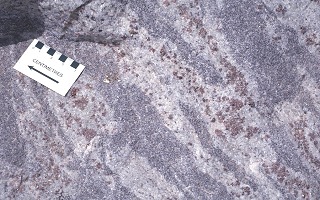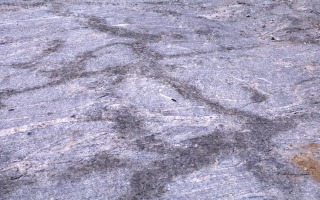Origin of Granulites
An annotated reading list
Introduction
A problem in dealing with this topic in a concise way is that granulite terrains vary widely in character, and granulite-facies rocks present many different sorts of phenomena to be explained. The basic petrological problem is that typical granulite-facies assemblages require PH2O << Ptotal for their stability, and debate has centred around how this low PH2O is achieved. There are three distinguishable models:
- Melting occurs, water from intergranular fluid and hydrous phases is partitioned into the melt, and the melt may be removed, taking the water with it.
- CO2-rich vapour from some external source passes through the rocks, driving dehydration reactions and diluting or flushing out the resulting aqueous fluid.
- In certain terrains the precursor rocks were already rather dry (e.g. water-deficient magmatic rocks and their dehydrated thermal aureoles) so that their subsequent high-grade metamorphism does not require a special mechanism to generate granulite-facies assemblages.
Other features of granulite terrains which need to be explained are:
- Depletion in large-ion lithophile elements (LILE).
- CO2-rich fluid inclusions.
- "Arrested charnockitisation"
This was regarded as a major issue in the 1970's when the focus was on the Lewisian gneisses, and it was ascribed either to melt extraction or to deep-seated fluid metasomatism. It is now realised that the Lewisian is atypical, being exceptionally depleted in LILE, whereas many granulite terrains show rather small depletions.
A classic study by Touret in southern Norway established that a change from water-rich to CO2-rich fluid inclusions coincided with the regional orthopyroxene isograd. This has been found to be generally true, though granulite terrains form a spectrum from those in which fluid inclusions are ubiquitous and abundant to those in which they are rare and small.
A strange phenomenon first described from south India and Sri Lanka, where in acid to intermediate rocks granulite-facies assemblages (charnockite) are found in vein-like arrays superimposed over amphibolite-facies gneisses. These features are now known, on a less conspicuous scale, from a number of other terrains. They have been attributed to CO2 streaming. Other explanations may be possible, but at the very least this phenomenon draws attention to the fact that the amphibolite-granulite transition cannot depend on changes in T or P alone.
- Pride, C., Muecke, G.K. (1980): Rare earth element geochemistry of the Scourian Complex, NW Scotland - evidence for the granite-granulite link. Contributions to Mineralogy and Petrology, 73, 403-412.
- Rollinson, H.R., Windley, B.F. (1980): Selective elemental depletion during metamorphism of Archaean granulites, Scourie, NW Scotland. Contributions to Mineralogy and Petrology, 72, 257-263.
- Weaver, B.L., Tarney, J. (1983): Elemental depletion in Archaean granulite-facies rocks. in: Migmatites, Melting and Metamorphism, Atherton, M.P., Gribble, C.D., Eds., Nantwich, Shiva, 250-263.
- Touret, J. (1977): The significance of fluid inclusions in metamorphic rocks. In: Thermodynamics in Geology, Fraser, D.G., Ed, Dordrecht, Reidel Pub. Co., 203-227.
- Touret, J. (1981): Fluid inclusions in high grade metamorphic rocks. In: Short Course in fluid inclusions: applications to petrology, Hollister, L.S., Crawford, M.L., Min. Assoc. Canada, Calgary, 182-208.
- Janardhan, A.S., Newton, R.C., Hansen, E.C. (1982): The transformation of amphibolite facies gneiss to charnockite in southern Karnataka and northern Tamil Nadu, India. Contributions to Mineralogy and Petrology, 79, 130-149.
Model 1: Melting and melt extraction
The original reference given for this model is usually Fyfe (1973), who suggested that granulites could be regarded as restites after removal of relatively large amounts of partial melt. The model has been suggested for the Lewisian Complex (see above).
- Fyfe, W.S. (1973): The granulite facies, partial melting and the Archaean crust. Philosophical Transactions of the Royal Society of London, A273, 457-462.
A substantial boost for the model came from the realisation that dehydration melting, i.e. vapour-absent incongruent melting of assemblages containing hydrous phases (Ms, Bt, Hbl) is likely to be an important process in high-grade metamorphism. Theoretical treatments were made by Thompson (1982), Powell (1983) and Grant (1985).
- Grant, J.A. (1985): Phase equilibria in partial melting of pelitic rocks. in: Migmatites, Ashworth, J.R., Ed., Glasgow, Blackie, 86-144.
- Powell, R. (1983): Processes in granulite-facies metamorphism. in: Migmatites, Melting and Metamorphism, Atherton, M.P., Gribble, C.D., Eds., Nantwich, Shiva, 127-139.
- Thompson, A.B. (1982): Dehydration melting of pelitic rocks and the generation of H2O-undersaturated granitic liquids. American Journal of Science, 282, 1567-1595.

Dehydration melting was applied to natural examples in Broken Hill, Australia (Phillips, 1980), New England (Tracy and Robinson, 1983) and Namaqualand, S. Africa (Waters and Whales, 1984; Waters, 1988). Notice, however, that these more recent accounts don't necessarily envisage the extraction of large volumes of melt.
- Phillips, G.N. (1980): Water activity changes across an amphibolite-granulite facies transition, Broken Hill, Australia. Contributions to Mineralogy and Petrology, 75, 377-386.
- Tracy, R.J., Robinson, P. (1983): Acadian migmatite types in pelitic rocks of central Massachusetts. in: Migmatites, melting and metamorphism, Atherton, M.P., Gribble, C.D., Eds., Nantwich, Shiva, 163-173.
- Waters, D.J., Whales, C.J. (1984): Dehydration melting and the granulite transition in metapelites from southern Namaqualand, S. Africa. Contributions to Mineralogy and Petrology, 88, 269-275.
- Waters, D.J. (1988): Partial melting and the formation of granulite facies assemblages in Namaqualand, South Africa. Journal of Metamorphic Geology, 6, 387-404.
Model 2: Influx of CO2-rich vapour

The type locality for this model is in south India, at classic exposures in stone quarries, e.g. at Kabbaldurga in the Late Archaean amphibolite-granulite transition zone, and further south in the Kerala "khondalite belt" where the phenomena are probably of Pan-African age (550 Ma). The model has been championed by R.C. Newton at Chicago.
- Newton, R.C., Smith, J.V., Windley, B.F. (1980): Carbonic metamorphism, granulites and crustal growth. Nature, 288, 45-50.
- Hansen, E.C., Newton, R.C. & Janardhan, A.S. (1984). Pressures, temperatures and metamorphic fluids across an unbroken amphibolite facies to granulite facies transition in southern Karnataka, India. In Kröner, A. et al., (ed.) Archaean Geochemistry, Springer-Verlag, 161-181.
- Newton, R.C. (1989): Metamorphic fluids in the deep crust. Annual review of Earth and Planetary Sciences, 17, 385-412.
Model 3: Metamorphism of dry precursors
The type area for this model is the Adirondack Highlands of upstate New York, where much of the terrain consisted of pre-orogenic pyroxene-bearing igneous rocks and their high-grade thermal aureoles, subsequently metamorphosed to give Grenville age (1000 Ma) granulite-facies assemblages.
- Lamb, W.M., Valley, J.W. (1984): Metamorphism of reduced granulites in low-CO2 vapor-free environment. Nature, 321, 56-58.
- Lamb, W.M., Valley, J.W. (1985): C-O-H fluid calculations and granulite genesis. in: The Deep Proterozoic Crust in the North Atlantic Provinces, Tobi, A.C., Touret, J.L.R., Eds., Dordrecht, D. Reidel, 119-131.
These three models are not mutually exclusive, and some authors have suggested interesting scenarios which allow elements of each model to be combined (e.g. Frost and Frost, 1987).
- Frost, B.R. & Frost, C.D. (1987). CO2, melts and granulite metamorphism. Nature, 327: 503-506.
P-T paths and tectonic setting
Again, a historical view is helpful in understanding the nature of the debate. By the end of the 1970's it was assumed that metamorphic rocks in orogenic belts typically experienced a clockwise P-T-time path (perhaps as a result of a casual reading of England and Richardson, 1977, J. Geol. Soc. London, 134, 201-213, a seminal paper of the time, although this paper actually suggested that high-T metamorphic belts might well not do this). So, when Ellis (1980) described an isobaric cooling history from Enderby Land he regarded it as unusual and exceptional. However, many more examples followed, and a variety of models were suggested to account for this type of retrograde path:
- Cooling at depth in the lower parts of thickened crust (Ellis, 1987)
- After metamorphism in extensional terrains (Sandiford and Powell, 1986)
- In terrains heated by the addition of voluminous magmas (Bohlen, 1987, see below)
- Ellis, D.J. (1980): Osumilite-sapphirine-quartz granulites from Enderby Land, Antarctica: P-T conditions of metamorphism, implications for garnet-cordierite equilibria and the evolution of the deep crust. Contributions to Mineralogy and Petrology, 74, 201-210.
- Ellis, D.J. (1987): Origin and evolution of granulites in normal and thickened crusts. Geology, 15, 167-170.
- Sandiford, M.A., Powell, R. (1986): Deep crustal metamorphism during continental extension: modern and ancient examples. Earth and Planetary Science Letters, 79, 151-158.
In some examples where parts of the prograde history could be detected, anticlockwise P-T paths were documented. In many cases, these were in terrains where magmatic accretion had played an important role in crustal thickening and heat advection. Some examples of models or applications are:
- Wells, P.R.A. (1980): Thermal models for the magmatic accretion and subsequent metamorphism of continental crust. Earth and Planetary Science Letters, 46, 253-265.
- Bohlen, S.R. (1987): Pressure-temperature-time paths and a tectonic model for the evolution of granulites. Journal of Geology, 95, 617-632.
- Warren, R.G., Stewart, A.J. (1988): Isobaric cooling of Proterozoic high-temperature metamorphites in the northern Arunta Block, Central Australia: implications for tectonic evolution. Precambrian Research, 40/41, 175-198.
- Waters, D.J. (1990): Thermal history and tectonic setting of the Namaqualand granulites, southern Africa: clues to Proterozoic crustal development. in: Granulites and Crustal Evolution, NATO-ASI series C-311, Vielzeuf, D., Vidal, P., Eds., Amsterdam, Kluwer, 243-256.
There seems now to be a broader recognition of the variety of P-T paths and tectonic settings to be found in granulite-facies terrains. The characteristic features which shed light on their P-T history are reviewed by
- Harley, S.L. (1989): The origins of granulites: a metamorphic perspective. Geological Magazine, 126, 215-247.
- Bohlen, S.R. (1991): On the formation of granulites. Journal of Metamorphic Geology, 9, 223-229.
Created October 1994